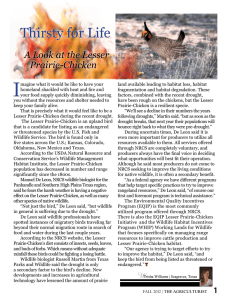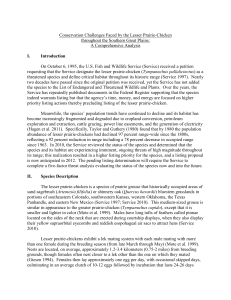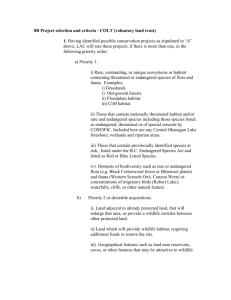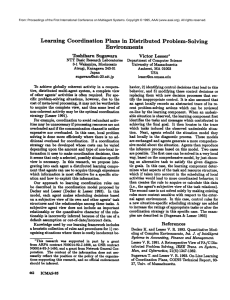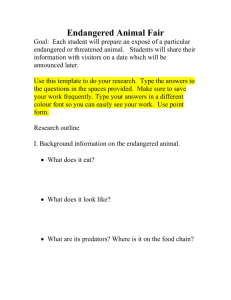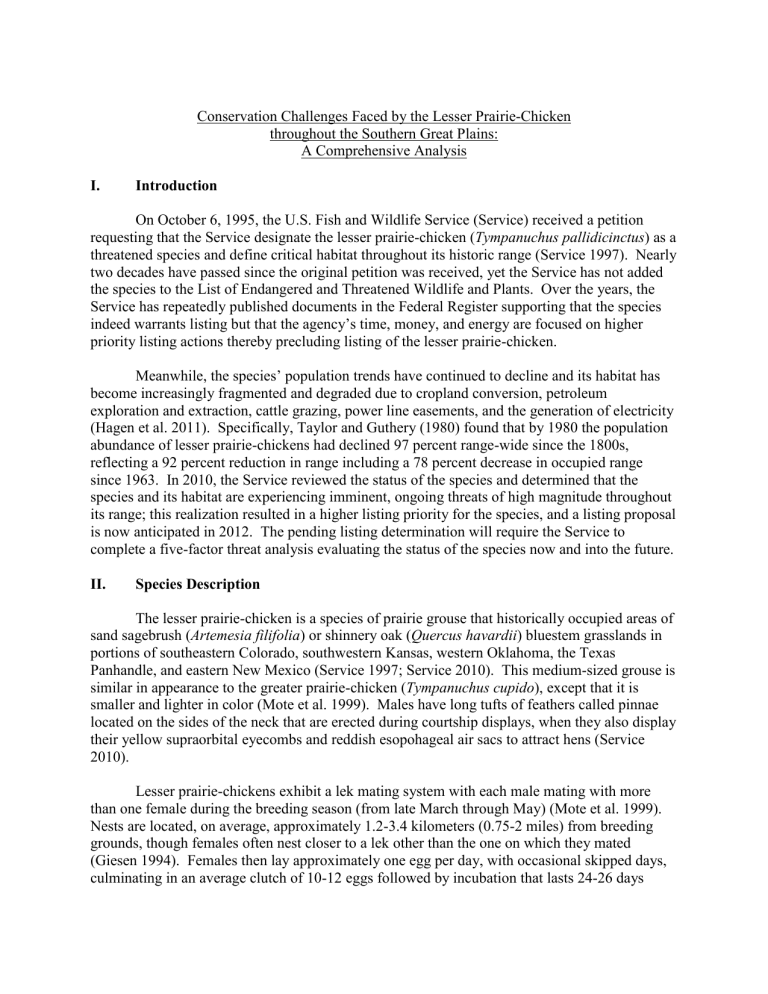
Conservation Challenges Faced by the Lesser Prairie-Chicken throughout the Southern Great Plains: A Comprehensive Analysis I. Introduction On October 6, 1995, the U.S. Fish and Wildlife Service (Service) received a petition requesting that the Service designate the lesser prairie-chicken (Tympanuchus pallidicinctus) as a threatened species and define critical habitat throughout its historic range (Service 1997). Nearly two decades have passed since the original petition was received, yet the Service has not added the species to the List of Endangered and Threatened Wildlife and Plants. Over the years, the Service has repeatedly published documents in the Federal Register supporting that the species indeed warrants listing but that the agency’s time, money, and energy are focused on higher priority listing actions thereby precluding listing of the lesser prairie-chicken. Meanwhile, the species’ population trends have continued to decline and its habitat has become increasingly fragmented and degraded due to cropland conversion, petroleum exploration and extraction, cattle grazing, power line easements, and the generation of electricity (Hagen et al. 2011). Specifically, Taylor and Guthery (1980) found that by 1980 the population abundance of lesser prairie-chickens had declined 97 percent range-wide since the 1800s, reflecting a 92 percent reduction in range including a 78 percent decrease in occupied range since 1963. In 2010, the Service reviewed the status of the species and determined that the species and its habitat are experiencing imminent, ongoing threats of high magnitude throughout its range; this realization resulted in a higher listing priority for the species, and a listing proposal is now anticipated in 2012. The pending listing determination will require the Service to complete a five-factor threat analysis evaluating the status of the species now and into the future. II. Species Description The lesser prairie-chicken is a species of prairie grouse that historically occupied areas of sand sagebrush (Artemesia filifolia) or shinnery oak (Quercus havardii) bluestem grasslands in portions of southeastern Colorado, southwestern Kansas, western Oklahoma, the Texas Panhandle, and eastern New Mexico (Service 1997; Service 2010). This medium-sized grouse is similar in appearance to the greater prairie-chicken (Tympanuchus cupido), except that it is smaller and lighter in color (Mote et al. 1999). Males have long tufts of feathers called pinnae located on the sides of the neck that are erected during courtship displays, when they also display their yellow supraorbital eyecombs and reddish esopohageal air sacs to attract hens (Service 2010). Lesser prairie-chickens exhibit a lek mating system with each male mating with more than one female during the breeding season (from late March through May) (Mote et al. 1999). Nests are located, on average, approximately 1.2-3.4 kilometers (0.75-2 miles) from breeding grounds, though females often nest closer to a lek other than the one on which they mated (Giesen 1994). Females then lay approximately one egg per day, with occasional skipped days, culminating in an average clutch of 10-12 eggs followed by incubation that lasts 24-26 days (Mote et al. 1999). The diet of the lesser prairie-chicken primarily consists of insects, seeds, leaves, buds, and cultivated grains (Giesen 1998). III. Issues & Objectives The research that follows will inform the Service’s upcoming listing rule that must propose the species as endangered, threatened, or not warranted for protection under the provisions of the Endangered Species Act. If the Service proposes that the species should be listed as either endangered or threatened, the information presented here may continue to be used to inform the final determination and the subsequent designation of critical habitat for the species after the necessary public and stakeholder involvement is conducted. Although the Service itself does not manage species on the ground, the agency relies upon partnerships with non-profit organizations, state agencies, private landowners, and industry to develop plans intended to return the species to self-sustaining populations. These partnerships are integral to conserving lesser prairie-chicken populations because 95 percent of the species’ occupied range is privately owned and the remaining 5 percent is managed by the Bureau of Land Management, U.S. Forest Service, and state agencies (Service 2010). Therefore, this information may be used as the basis for management recommendations intended to conserve the lesser prairie-chicken and its habitat. Ecology Objectives Use existing statistical and GIS data presented in the best available scientific literature to illustrate the distribution of the lesser prairie-chickens’ occupied habitat within the study area. The Lesser Prairie-Chicken Interstate Working Group updates GIS layers to map the entirety of the occupied range of the species by incorporating lek information and movement locations of the species across the range (Playa Lakes Joint Venture 2011). This information will display a significant reduction in the species’ historic range to its currently occupied range. Second, draw upon existing scientific literature to describe the population trend of the species within the study area. Sullivan et al. (2001) used intensive surveys occurring since 1942 to describe long-term population trends of lesser prairie-chicken in the 12 currently occupied counties that exist in Texas by evaluating the average number of males per lek and leks per unit area. Likewise, Woodward et al. (2001) analyzed landscape composition of five study sites in three Texas counties, along with others in New Mexico and Oklahoma, to quantify landscapelevel composition and change of landscapes surrounding leks and determine whether or not these variables were related to population trends between 1959 and 1996. This information will be used to present the ecological foundation for the species’ current population status throughout the study area. Human Dimensions Objectives Identify and describe pertinent anthropogenic stressors leading to habitat degradation and loss for the lesser prairie-chicken in the study area. Habitat fragmentation as a result of human development represents a pressing issue for the species due to its avoidance behavior towards anthropogenic features on the landscape; Hagen et al. (2011) found support for avoidance of power lines, paved roads, buildings, and wells, and identified minimum footprints that are likely to be avoided when selecting habitat. Within the study area, it is predicted that future development will continue, and specifically that wind energy development in the Texas Panhandle and portions of west Texas represent a serious threat to the lesser prairie-chicken populations present in the state (Service 2010). Projected development within the species’ range must be described to better understand potential lesser prairie-chicken population trends now that studies have verified the effect of such development on the species to date. Second, qualitatively describe the affect collaborative conservation programs have had on lesser prairie-chicken conservation despite the lack of a listing proposal for the species. This requires a discussion of the various approaches to habitat and species conservation initiated by the U.S. Fish and Wildlife Service, the five applicable state wildlife agencies, U.S. Forest Service, Bureau of Land Management, and Natural Resource Conservation Service, in conjunction with private landowners. These agencies maintain databases that outline the number of private landowners and amount of acres enrolled in the various conservation efforts for the species. This information will be presented to better understand the progress that has been made, without having a threatened or endangered designation for the species, to protect and conserve the species. Economics Objectives Describe the economic impacts of the pending listing decision for the lesser prairiechicken within the study area. Mote et al. (1999) administered a survey of over 25,000 individuals within the lesser prairie-chicken range to better understand social and economic considerations related to the species’ population. The public responded outlining current and potential issues including commercial value, recreational value, biotic value, scientific value, aesthetic value, legal obligations, and ethical responsibilities (Mote et al. 1999). These responses present a qualitative analysis of potential economic impacts to local communities throughout the species’ range, including that of the study area. Policy Objectives Identify the law, regulation, and policy that affect current management of the lesser prairie-chicken, and identify how a decision to list the species as threatened or endangered would alter management of the species. The species is currently only considered a “candidate” for listing under the Endangered Species Act, and management lies entirely under the jurisdiction of the five state wildlife agencies within the species’ current range. A decision to list the species as threatened or endangered would elevate protection to the species and prohibit “take” of the species under section 9 of the Endangered Species Act. A description of the Endangered Species Act, along with its definition of a threatened species and an endangered species, is necessary to understand the ramifications of a listing decision that would place the species on the List of Endangered and Threatened Wildlife and Plants. If the Service determines that the species is not warranted for protection under the Endangered Species Act, management will remain in the hands of the state wildlife agencies. Paez (2009) presents a provocative analysis of the effectiveness of the Endangered Species Act and the Service’s collaborative conservation initiatives in conserving populations of the lesser prairie-chicken, and this information may be used to assist in addressing the policy objectives of this proposal. IV. Study Site Although the current range of the lesser prairie-chicken reaches into portions of Colorado, Kansas, Oklahoma, Texas, and New Mexico, the study revolves around the lesser prairie-chicken populations currently present in the Southern Great Plains, specifically those in the Texas Panhandle and portions of western Oklahoma. Studies relied upon for the data presented in the research that will follow involved specific study sites within this region, but the majority of the data presented will focus on the Texas populations. This study has been narrowed down to focus primarily on Texas populations because there is a strong research background for the area and because of the projected trends in wind energy development throughout the landscape, which is thought to comprise a serious threat to the species. This area has already experienced a notable population decline in the species and the threats impacting the species are expected to increase more rapidly and have more significant impacts to the species' habitat in this area than in the remainder of the species' current range. Literature Cited Bell, L.A., S.D. Fuhlendorf, M.A. Patten, D.H. Wolfe, and S.K. Sherrod. 2010. Lesser prairiechicken hen and brood habitat use on sand shinnery oak. Rangeland Ecology and Management 63(4):478-486. Giesen, K.M. 1994. Movements and nesting habitat of lesser prairie-chicken hens in Colorado. Southwestern Naturalist 39(1):96-98. Giesen, K.M. 1998. The lesser prairie-chicken. In Birds of North America, No. 364, A. Poole and G. Gill, eds. Philadelphia: the Academy of Natural Sciences; Washington, D.C. The American Ornithologist’s Union. Hagen, C.A., J.C. Pitman, T.M Loughin, B.K. Sandercock, R.J. Robel, and R.D. Applegate. 2011. Impacts of anthropogenic features on habitat use by lesser prairie-chickens. Pp. 63-75 in B.K. Sandercock, K. Martin, and G. Segelbacher (editors). Ecology, conservation, and management of grouse. Studies in Avian Biology (vol. 39), University of California Press, Berkeley, CA. Mote, K.D., R.D. Applegate, J.A. Bailey, K.E. Giesen, R. Horton, and J.L. Sheppard, Technical Editors. 1998. Assessment and conservation strategy for the lesser prairie-chicken (Tympanuchus pallidicinctus). Emporia, KS: Kansas Department of Wildlife and Parks. Paez, S.A. 2009. Preventing the extinction of candidate species: the lesser prairie-chicken in New Mexico. University of New Mexico School of Law: Natural Resources Journal 49(2):525-582. Playa Lakes Joint Venture. 2011. Lesser Prairie-Chicken Tools. Available at: http://www.pljv.org/partners/gis-tools/lepc-tools. Updated 2011. Accessed 9/21/2012. Sullivan, R.M., J.P. Hughes, and J.E. Lionberger. 2001. Review of the historical and present status of the lesser prairie-chicken (Tympanuchus pallidicinctus) in Texas. U.S. Fish and Wildlife Publications. Paper 33. http://digitalcommons.unl.edu/usfwspubs/33 Taylor, M.A., and F.S. Guthery. 1980. Status, ecology, and management of the Lesser Prairie Chicken. U.S. Department of Agriculture, Forest Service General Technical Report RM77, Rocky Mountain Forest and Range Experimental State, Fort Collins, CO. U.S. Fish and Wildlife Service (Service). 1997. Endangered and Threatened Wildlife and Plants; 90-Day Finding for a Petition to List the Lesser Prairie-Chicken as Threatened. Federal Register 62(13):36482–36484. U.S. Fish and Wildlife Service (Service). 2010. Lesser Prairie-Chicken: Species Assessment and Listing Priority Assignment Form. Southwest Regional Office: Albuquerque, NM. Woodward, A.J., and S.D. Fuhlendorf. 2001. Influence of landscape composition and change on lesser prairie-chicken (Tympanuchus pallidicinctus) populations. American Midland Naturalist 145:261–274.
